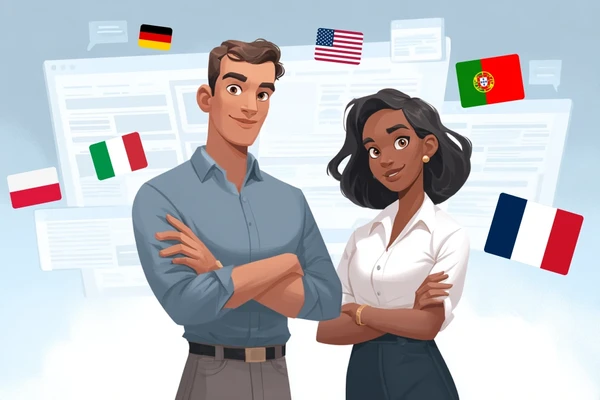Did you know? Out of over 1.1 billion websites, only about 193.5 million are active—that's just 18%! And every three seconds, a new website adds to this number.
Ever wondered how we got here? Let's jump into the past and explore how we transitioned from simple, table-based websites to the rich, interactive web experiences of today.
Start Here!
90s web design and early websites
During the 90s, early websites were simple, often built with basic HTML and reliant on tables for structuring content because CSS wasn't yet a staple in design toolkits. Visuals were minimal due to the slow internet speeds of the time, which necessitated quick loading times. The design elements might seem rudimentary now—think stark backgrounds, conspicuous buttons, and tiled GIF backgrounds—but they were cutting-edge at the time.
These early designs, though technologically surpassed, carry a nostalgic allure and have sparked a resurgence in popularity as part of the "retro web" trend. This trend celebrates the internet's formative years and its distinctive aesthetic.
I personally recall the excitement of the digital frontier back then. In 1989, the thrill began when my brother and I received our first Amiga 500. The following year, our dad started teaching us how to program. It was an exhilarating introduction to what technology could do, echoing the broader, world-changing digital revolution that was just beginning.
90s website design characteristics
- Bright backgrounds and fonts: Websites were often a visual shout rather than a whisper, with loud, bright background colors and bold fonts. The infamous Comic Sans, for instance, made its way into many a web designer's toolkit during this time.
- Animated GIFs: The animated GIF became a staple of 90s web design. These small, looping animations added life and movement to pages.
- Navigation via hyperlinks: Early websites heavily relied on hyperlinks for navigation. Text links, often underlined in bright colors, guided users through their web journey.
- Early multimedia: Back then multimedia on websites was often inconsistent before the advent of modern streaming and media embeds. Tools such as Macromedia Shockwave (later Adobe Shockwave) and Adobe Flash bridged this gap, enabling designers to incorporate videos, music, and interactive content that plain HTML couldn't support on its own.
- Page hit counters: Those were a small digital badge of honor, showing off how many visitors a site had attracted.
- Animated text: Marquee tags, which allowed text to scroll across the screen, were a popular and eye-catching feature on websites, even if they could be a bit overwhelming at times.
- Splash pages: These were the billboards of the internet highway, often the first page you’d see when visiting a website. Splash pages typically featured bold graphics, animations, and sometimes a "click here to enter" type of message, all designed to create a big first impression.
- Tiled backgrounds: The visual design often included tiled backgrounds that repeated small images across the screen, giving pages a textured or noisy look.
- Neon colors: Neon colors added a sense of vibrancy to webpages, making the digital environment feel energetic and dynamic.
- 3D buttons: 3D-style buttons contributed to the sense of depth on a webpage, enhancing the user experience by making interfaces feel more interactive and engaging.
Get started
No coding experience required.
90s web design and 90s website builders timeline
- 1991: Tim Berners-Lee launches the world's first website on August 6. He also created the first web browser and editor, WorldWideWeb, a simple WYSIWYG tool that allowed users to see what the end result would look like while crafting web pages.
- 1992: The first image is uploaded to the internet, featuring the band Les Horribles Cernettes, symbolizing the start of multimedia integration online.
- 1994: Amazon.com was launched by Jeff Bezos, as one of the first online stores.
- 1994: Yahoo! began as a web portal, registering its domain in 1995 and launching a search engine shortly thereafter.
- 1995: The first official use of web design for marketing was the Batman Forever website by Jeffrey Zeldman, Steve McCarron, and Alec Pollak.
- 1995: JavaScript was developed by Brendan Eich of Netscape, enabling more dynamic and interactive websites. Netscape Navigator 2.0, supporting animated GIFs, was also released this year.
- 1996: The World Wide Web Consortium (W3C) introduced Cascading Style Sheets (CSS1), revolutionizing how websites were styled and marking a shift towards more sophisticated design capabilities.
- 1997: Macromedia releasing Dreamweaver 1.0, a game-changer for web design with its user-friendly interface for creating websites.
- 1998: Beginning of Google- starting as a simple search engine and eventually becoming a giant in web services.
- 1999: The first Web Content Accessibility Guidelines (WCAG 1.0) were published by W3C, aiming to make the web more accessible to all users.
- 1999: Debut of favicons (those tiny icons/logos in browser tabs).
1990s website examples

Early 2000s web design
The early 2000s marked a pivotal era in web design history, transitioning from the experimental styles of the 90s to more refined and user-centric designs. This period was characterized by rapid technological progress and a shift in design philosophies as developers and designers embraced new tools, techniques, and standards to enhance user experience.
A key advancement was the widespread adoption of Cascading Style Sheets (CSS). CSS allowed designers to separate visual design elements from the HTML structure by storing visual rules in separate files. The use of CSS led to cleaner, more consistent, and visually engaging websites that loaded faster and were easier to navigate.
During this transformative time, I was deeply immersed in the world of technology and web design, as my brother Wojtek and I began our computer science studies at Wrocław University of Science and Technology. Our education coincided with these exciting changes in the digital landscape, allowing us to witness and participate in the evolution of web technologies firsthand.
Early 2000s website design characteristics
- Table-based layouts: While CSS was gaining traction, many websites still used tables for layout purposes. This method allowed designers to create more structured and organized designs compared to the freestyle layouts of the 90s.
- Navigation: Designers implemented clearer, more intuitive navigation bars and menus. Hierarchical menus and breadcrumb navigation started to become common, helping users understand their location within a website.
- Gradients, shadows, and glossy effects: The aesthetic of early 2000s web design often included visual enhancements like gradients, shadows, and glossy effects, which added depth and realism to the interfaces.
- More professionalism: Moving away from the flashy GIFs of the 90s, the early 2000s saw a reduction in animations and a push towards a more professional online presence.
- Forums, logs, and early social networks: These platforms allowed users to engage through comments, posts, and threads, facilitating community building and user-generated content.
- Metadata: Enhancements in metadata usage allowed for better SEO practices and more structured data storage.
- Tagging: The concept of "tagging" keywords on websites helped in categorizing content more efficiently, which was essential for search engine indexing and user search capabilities.
- Software as a Service (SaaS): The early 2000s witnessed the growth of SaaS, where software applications were hosted online and available as a service rather than standalone products.
- "Like" buttons: The introduction of the "like" button and other social signals became a new way for users to interact with content.
Early 2000s web design timeline
- 2001: The foundation of Wikipedia by Jimmy Wales and Larry Sanger offered a multilingual, web-based encyclopedia that anyone could edit, revolutionizing information sharing.
- 2001: SVG 1.0 was introduced, enhancing web graphics with scalable vector graphics that do not lose quality when zoomed or resized.
- 2001: Audi.com launched as the first partially “responsive” website, pioneering adaptations in web design for different screen sizes.
- 2003: Matt Mullenweg and Mike Little created WordPress 0.7, a game-changing open source content management system.
- 2003: Apple released Safari 1.0, expanding the web browser ecosystem.
- 2003: MySpace was founded by Tom Anderson and Chris DeWolfe.
- 2004: The term Web 2.0 was popularized, emphasizing user-generated content, usability, and interoperability for end users.
- 2005: Launch of Google Maps.
- 2005: YouTube was launched, becoming the premier platform for video sharing.
- 2005: Reddit started as a new social news aggregation, web content rating, and discussion website.
- 2005: Google Analytics began helping websites track and report traffic effectively.
- 2006: Twitter, which introduced a new microblogging platform where users post and interact with messages known as "tweets".
- 2006: Beginning of Wix - website builder.
- 2007: Steve Jobs unveiled the first iPhone, changing mobile technology and web consumption forever.
- 2007: Netflix launched its streaming media service, heralding a shift in how media is consumed.
- 2007: W3C released the first proposal of the CSS Grid specification, aimed at improving web layout capabilities.
- 2008: Google Chrome was released, offering a fast, free web browser that has since become the most widely used browser worldwide.
- 2008: Stack Overflow was established, quickly becoming an essential resource for programmers worldwide.
- 2008: WCAG 2.0 guidelines were issued by W3C, enhancing web accessibility standards.
- 2009: Facebook introduced the “like” button.
- 2009: Microsoft launched Bing, its search engine.
- 2009: Dribble began as a community for showcasing creative work by designers and artists.
Early 2000s website examples

2010 website design and mid 2000s websites
During this web design timeline, designers were experimenting with more complex layouts and dynamic content as broadband internet became more widespread. The use of multimedia elements like Flash began to decline as HTML5, CSS3, and JavaScript matured, offering more robust and accessible alternatives for animations and interactions.
Our no-code website builder, BOWWE, was introduced in 2014, making it easier for anyone, regardless of technical skill, to create beautiful, functional websites. This tool exemplifies the democratization of web design, allowing more people to participate in web creation without needing to understand coding or advanced web technologies. You can check out BOWWE potential for free now - start now!
Mid 2000s website design characteristics
- Skeuomorphism: This design philosophy aimed to make digital interfaces intuitively familiar by mimicking real-world materials such as leather, metal, and wood.
- Frutiger aero: Inspired by Microsoft’s Aero interface, this design trend featured glossy, semi-transparent elements that gave a sense of depth and a techy, futuristic look.
- Responsive design: Designers started to consider how their websites would appear on various devices, leading to the initial efforts in designing mobile websites to improve accessibility and user experience on smartphones and tablets.
- Material design: Introduced by Google, Material Design was a visual language that incorporated grid-based layouts, responsive animations and transitions, padding, and depth effects such as lighting and shadows.
- Parallax scrolling: By making background images move slower than foreground images, Parallax Scrolling created an illusion of depth in a 2D scene, enhancing storytelling and user engagement on websites.
- Flat design: This style emphasized clean lines, solid colors, and a lack of gradients, shadows, and textures.
Mid 2000s web design timeline
- 2010: Pinterest was launched.
- 2010: A proposal for the Web Open Font Format (WOFF) was submitted to the W3C, enhancing font accessibility and variety on the web.
- 2010: Google Web Fonts (now Google Fonts) was launched, providing an open-source library of web fonts.
- 2010: Instagram debuted, revolutionizing photo sharing on the web.
- 2010: Microsoft launched Windows Phone 7, which introduced a new mobile operating system emphasizing clean design and integration with Microsoft's services.
- 2011: Bootstrap, a powerful, mobile-first CSS framework, was developed by Mark Otto and Jacob Thornton of Twitter, significantly impacting responsive design practices.
- 2011: Stripe was launched, simplifying online payments.
- 2012: W3C issued an official recommendation for Media Queries, a key technology in responsive web design.
- 2012: TypeScript, a superset of JavaScript developed by Microsoft, was introduced to add static types to the language, enhancing scalability and maintenance for larger web projects.
- 2013: React, a JavaScript library for building user interfaces, was released.
- 2013: Webflow (website builder) was launched.
- 2014: Beginning of BOWWE, our no-code website builder, was introduced, democratizing web design by enabling users to create sophisticated websites without coding.
- 2014: HTML5 was officially recommended by the W3C.
- 2015: Microsoft Edge was launched, replacing Internet Explorer as Microsoft's default web browser.
- 2016: Figma was launched.
- 2017: The termination of Flash.
Mid 2000s website examples

Present web design
Modern designs blend minimalism with visually engaging elements to create interfaces that are not only beautiful but highly functional. Current web design trends emphasize a user-centered approach, prioritizing the experience and interaction of users with web platforms.
Our platform has embraced these modern design trends by incorporating new AI-driven features that streamline the creation and management of web projects:
- AI Image Generator: This tool allows users to create custom images with help of AI tailored to their site’s aesthetics, providing unique visuals that enhance the overall design.
- AI Text Generator: By harnessing the power of AI, our text generator facilitates the rapid creation of compelling and pertinent content.
- AI Multilanguage features: Perhaps one of the most groundbreaking features is the ability to create multilanguage web projects with just one click. This functionality supports global reach and accessibility, making websites usable and approachable for a diverse audience.
- Mobile First design: Emphasizing the importance of optimizing for smaller screens first, our platform ensures that web designs are responsive and user-friendly across all devices, starting with smartphones.
BOWWE Builder incorporates advanced AI features to simplify web design and project management. Explore BOWWE Builder to discover how it can enhance your web creation process. Sign up for free.
Get started
No coding experience required.
Present website design characteristics
- Typography, illustration, and visual elements: Modern web design places a strong emphasis on creative visuals. Bold typography and intricate illustrations are used not just for aesthetic appeal but also for storytelling and user engagement.
- Data-driven design with user data protection: Websites today are increasingly designed based on user data to enhance effectiveness and user experience. However, there's a simultaneous focus on protecting this data, adhering to privacy laws and ethical standards.
- Personalization: Tailoring website content and functionality to individual users’ preferences is more prevalent than ever.
- White space: The use of white space, or negative space, is a critical element in modern web design.
- Focus on speed: With the increasing importance of SEO and user experience, design decisions are often influenced by the need to have fast-loading web pages.
- AI-driven design: Artificial intelligence is increasingly used in web design to automate processes like image generation, content creation, and more, significantly speeding up development times and personalizing user interactions.
- Glassmorphism: This design trend involves creating a frosted-glass effect where backgrounds are blurred behind semi-transparent panels, adding depth and a touch of modern aesthetics to interfaces.
- Depth effects and 3D elements: Adding depth through shadows, layers, and 3D animations is a popular method for capturing user attention and enhancing the visual hierarchy of a design.
- The Metaverse and 3D experiences: As virtual reality and augmented reality technologies mature, more websites are incorporating 3D environments and elements that tie into the burgeoning concept of the Metaverse, providing immersive experiences that go beyond traditional browsing.
- Micro-interactions: Small interactions, like hover effects, loading animations, or subtle sound effects, play a significant role in enhancing the user experience.
- Low-Code and No-Code platforms: These platforms have democratized web design, allowing people without extensive programming knowledge to build and manage websites, which accelerates development and encourages innovation.
- Sustainability: There’s an increasing focus on creating websites that are environmentally friendly, considering aspects like energy consumption for data transfer and hosting, which ties into a broader commitment to sustainability.
- Dark mode: Popular among users for its aesthetic and practical benefits, dark mode offers an eye-friendly alternative to traditional bright screens, reducing eye strain in low-light conditions and saving on device energy consumption.
Present web design timeline
- 2020: Google introduced Google Analytics 4, a new generation of analytics designed to provide user data with privacy at its core.
- 2021: OpenAI released DALL-E, an AI program capable of creating images from textual descriptions.
- 2021: Facebook company was renamed "Meta" and its chairman Mark Zuckerberg announced a commitment to developing a metaverse, shifting focus towards more immersive, 3D web experiences.
- 2022: OpenAI launched ChatGPT.
- 2022: Midjourney became open beta.
- 2023: Microsoft announced the integration of OpenAI’s GPT-4 model into Bing.
- 2023: Google Universal Analytics stopped processing data, pushing websites to transition to Google Analytics 4.
- 2024: Launch of AI Overviews in Google search engine.
- 2024: Introduction of new AI features to BOWWE Website Builder: Our tool implemented advanced AI features, such as AI Image Generator, AI Text Generator, and AI Multilanguage capabilities, making web design more accessible and efficient.
- 2024: OpenAI introduced a search engine into ChatGPT.
Present website examples
Web design history - summary
As we've seen, the evolution of web design has been influenced by a myriad of factors, including technological breakthroughs, changing user expectations, and the ever-expanding capabilities of internet infrastructure. Each decade brought its own set of trends and tools, from the text-heavy pages and simple HTML of the early days to the immersive, interactive web experiences enabled by AI today.
Reflecting on the history of web design not only informs us about where we’ve been but also inspires us about where we are headed. It encourages ongoing innovation and adaptation in a field that is never static, always pushing the boundaries of what is possible in the digital domain.
Start Here!

Karol is a serial entrepreneur, e-commerce speaker m.in for the World Bank, and founder of 3 startups, as part of which he has advised several hundred companies. He was also responsible for projects of the largest financial institutions in Europe, with the smallest project being worth over €50 million.
He has two master's degrees, one in Computer Science and the other in Marketing Management, obtained during his studies in Poland and Portugal. He gained experience in Silicon Valley and while running companies in many countries, including Poland, Portugal, the United States, and Great Britain. For over ten years, he has been helping startups, financial institutions, small and medium-sized enterprises to improve their functioning through digitization.







